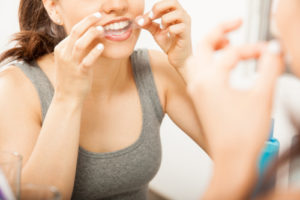Over-the-Counter Teeth Whitening Products—What You Need to Know
Teeth whitening is a multi billion dollar industry that just keeps growing.There is now a wider variety of teeth whitening products available over the counter, and it can be difficult to know which ones might work for you.This blog highlights the important things you need to know if you want to use over-the-counter teeth whitening products.
The Difference between Whitening and Polishing

Many products, especially toothpastes, claim to be whitening, when actually they are simply polishing external stains from the teeth.Whitening, or bleaching the teeth, changes the overall color of the tooth.Polishing allows you to return your teeth to the original shade before staining occurred.
If you drink large amounts of coffee, tea, red wine or use any type of tobacco, most of your discoloration is probably the result of external staining.This means that polishing the teeth with a whitening toothpaste or powder may accomplish your smile goals.
Polishing the outer stains from the enamel involves the use of abrasive particles.Because of this abrasive action, it is important to be cautious when using these products.Areas of thin enamel could become even thinner.Roots exposed by gum recession are easily abraded and made sensitive by whitening toothpastes.
Whitening toothpastes are a great way to maintain a white smile.Just ask Dr. Ann and Dr. Lauren to confirm that you will not do any damage to your teeth with an abrasive toothpaste first.
Ingredients
Choosing an over-the-counter whitening product is very simple when you understand one important aspect of teeth whitening.There are only two chemicals that will penetrate the tooth enamel and actually change the color of the teeth, and they are related to each other: hydrogen peroxide and carbamide peroxide.This makes it very easy to tell if the product will actually bleach the teeth.
If an over-the-counter whitening product does not contain a peroxide compound, then it will not change the tooth’s color.Most likely, it is relying on some abrasive particle to polish external stains.While there is nothing wrong with that mechanism of action, it can only get you so far in whitening your teeth.
There are some companies and sites claiming that peroxide chemicals are dangerous or harmful.There is currently no scientific research showing any adverse effects from teeth whitening products containing peroxides when you use them appropriately.
Application Method
Aside from the active ingredient being a peroxide compound, the next most important aspect of a teeth whitening produce is how long it remains in contact with your teeth.It takes time for peroxides to penetrate the tooth enamel and begin breaking down (oxidizing) dark compounds within the tooth structure.If your whitening product does not stay on the teeth for at least 10-15 minutes, you cannot expect much of a whitening result.
This means the method of application is important.For instance, most whitening mouth-rinses do contain hydrogen peroxide.The problem is that you don’t swish for more than one to two minutes, so there is not time for the peroxide to change your tooth color.
It is also VERY important to understand that while peroxide chemicals are perfectly safe on hard tooth structure, like enamel, they are NOT safe for the rest of your mouth.They are just too harsh for the delicate soft tissues of your cheeks, lips, tongue and gums.So do not hold peroxide in your mouth for 10-15 minutes in an attempt to whiten your teeth.
The best method of applying teeth whitening products to your teeth is with a mold or tray that holds the liquid or gel up against the teeth.This ensures that the peroxide chemicals only touch the teeth and protects the soft tissues of your mouth.
What to Avoid
There are some people who should not attempt teeth whitening without the supervision of their dentist.If you fall into any of these categories, come see Dr. Ann or Dr. Lauren for a teeth whitening consultation first.
- If your teeth are sensitive to hot and/or cold liquids, do not attempt any teeth whitening without talking to your dentist first.Whitening toothpastes are abrasive and can remove important insulating tooth structure.Peroxide gels can increase hypersensitivity of the nerve in a tooth.It is important to address your sensitivity first with the dentist.Then we can help you choose a teeth whitening option that will give you the smile you want without causing extra sensitivity or pain.
- If you have untreated dental problems like cavities and severe gum disease, you should see your dentist before attempting to whiten your teeth.The teeth whitening products can aggravate the nerve, causing increased pain from teeth with dental problems.
- If you have any soft tissue disorders that affect the lining of the inside of your mouth (usually autoimmune diseases), avoid any over-the-counter whitening products.You can still whiten your teeth, but you need the direct supervision of the dentist and complete protection of all the lips, cheeks, tongue and gums from contact with any chemical.
What About Oil Pulling?
We’ve got good news and bad news about oil pulling.The good news is that it is perfectly safe, and it does have some support in medical research for improving or maintaining good oral health.
The bad news is that s odes not whiten your teeth.The oil does not draw stains out of the enamel, and it does not make any difference in the color of your teeth.
So if you’re interested in oil pulling, go for it!Just don’t expect it to whiten your teeth.
Disclaimer:The safest, most predictable way to whiten your teeth is by using professional teeth whitening gel in custom-fitted trays to hold the gel in place while protecting the soft tissues.
More Questions about OTC teeth Whitening Products?
Contact Designer Smiles today to set up a consultation with Dr. Ann and Dr. Lauren.They can answer any questions you have about over-the-counter teeth whitening and help you choose the product that is best for you.
